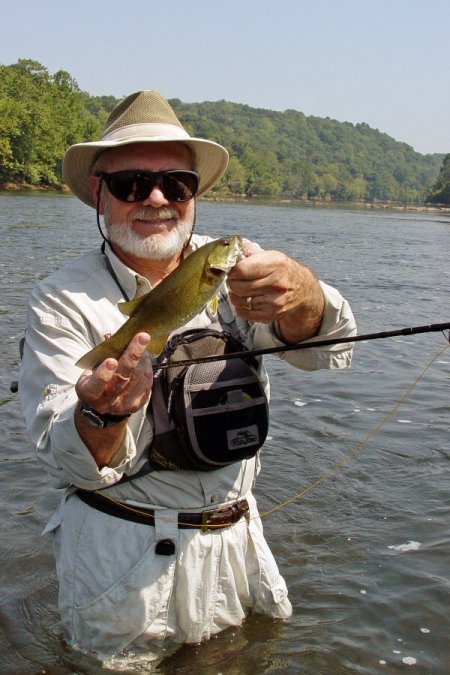Small mouth bass fishing in the New River in Virginia.
Ever fished in a city park? Okay, ever fished in a city park that includes a mile of pristine mountain river that's bordered on both banks by large trees? Okay, how about fishing in a city park that includes a mile of pristine river bordered on both banks by large trees and actually caught lots of fish.
Now you know why we recently drove into Virginia to catch fish. And that fish is the pugnacious small mouth bass. Arguably the "fightingest" of the sunfish group that include large mouth bass and bluegill, these fish rarely get over 2-3 pounds in our mountain rivers, but what they lack in size they make up in heart.
Nightcrawler Patterson and I met Capt. Kirk Drowne in the Cracker Barrel Restaurant parking lot off I-77 at Mooresville early in the morning to drive to his familiar water: the New River in Radford, VA. During the 3 hour drive, Kirk explained that when we crossed into Virginia we were out of the granite rock of North Carolina and its "free stone" streams and into the limestone of Virginia and its spring-fed streams. The latter have a lot more fish per river mile because the minerals in the limestone create areas rich in water plants and all the small creatures that live among them. And the larger fish, including "smallies" come to feed.
We pulled into Bisset Park, which is in the city limits of Radford, to park. I looked at Kirk and said, "This is a city park?"
"Yep. This 58 acre park includes both banks of the New River for over a mile and runs through the town of Radford."
I couldn't believe it. All we saw were trees bordering a beautiful broad river. And the town of Radford was on both sides of us. Amazing. The foresight that the city leaders and its citizens had when they decided to buy all this beauty and keep it that way is remarkable.
Due to the relative warmth of the water, mid-sixties, we didn't bother putting on waders and just wet waded the river. Of course we had our felt-soled wading boots on. Always a prudent act when walking over slippery rocks.
Kirk showed Nightcrawler and me why the area was such a good fishery when he turned over a large rock. Squatting there with his blue claws menacing us, was a very large crayfish. In fact, I'd never seen one so big. Kirk said he'd need to find a smaller one for bait, so he poked around, caught a smaller one and put it on the hook of his spinning outfit.
Nightcrawler and I enjoy fly fishing, so we put on our crayfish imitations, and began casting into waist deep water. It didn't take long. The 'Crawler's rod bent over, he hooped-the boy has a tendency to get excited when he fishes-and after a brisk struggle and a couple of jumps, netted a nice one-pound smallie.
Kirk caught a two-pounder on his crayfish. We photographed and released it (the bass, not the crayfish), and went back to fishing.
This went on all morning. I was very surprised to see how little it was necessary to move along the river to catch fish. This limestone river is full of fish. Between the three of us, we caught over 40 and didn't go more than a couple of hundred yards either way from where we first entered the river. This would not happen across the border into Ashe County, NC, where we've fished the New River there. Freestone streams don't produce the nutrients to support the aquatic base of plants and small crustaceans necessary to have so many game fish in such a comparatively small area.
Each time I hooked a smallie in the river current, I was convinced the fish was twice as big as it ended up being. The ones we caught on flies averaged both sides of a pound. I believe larger flies would've caught bigger fish, but we used what we brought. And the smallies hit everything from streamers to nymphs to small crab imitations designed to catch salt-water fish.
The method we used to catch the small mouth bass was pretty much the same known as "nymphing" for trout. The weighted fly needs to be bouncing the bottom. The big difference between smallies and trout is the strike. Trout often spit out a small fly so quickly the fisherman never has a clue, but smallies usually clobber the fly, so there's no doubt about a hit. The larger flies used for small mouth may make a difference, too, since fish attack larger flies more aggressively than smaller ones.
We caught the bass in shallow water and deep water, but the fishing was best in water that was highly oxygenated.
And the access was very easy from the parking lot to the river. Many places that have river access require parking high above on a busy road and scrambling down to the river, so the access from Radford City Park was a pleasant surprise.
If you want to catch small mouth bass in a beautiful mountain river setting, give Capt. Kirk-Yeah, I'm trying to avoid the "Star Trek" jokes, too-a call and look forward to a fun day.
If you're going:
Capt. Kirk Drowne can be contacted at:
Phone: 001 704.787.1653
or:
Madison River Fly Fishing Outfitters
Phone: 001 704.896.3676














